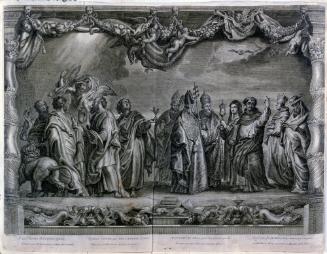The Four Evangelists
Artist
Peter Paul Rubens
(Flemish, 1577 - 1640)
Datec. 1625
CultureFlemish
MediumOil on canvas
ClassificationPaintings
ProvenanceInfanta Isabella Clara Eugenia, Coudenbergh Palace, Brussels, ca.1627-28-her death, 1633; by inheritance to her nephew, the Cardinal-Infante Ferdinand, Coudenbergh Palace, Brussels, 1633-his death, 1641; by inheritance to his brother, King Philip IV of Spain; sent to Spain ca.1648-49; possibly given as a gift to Don Luis Méndez de Haro, Marqués del Carpio [1599-1661]; given to the Church of the Discalced Carmelite Nuns, Loeches (after 1649); possibly purchased from the convent, circa 1808, by George August Wallis, on behalf of William Buchanan; confiscated in Madrid by French authorities; purchased by Count Edmund de Bourke, Danish Plenipotentiary at Madrid and sold by him in 1818 to Robert, Second Earl Grosvenor, 1st Marquess of Westminster, Grosvenor House, London for £10,000, 1818-his death; by inheritance to his son, Richard Grosvenor, Second Marquess of Westminster [1795-1869], Grosvenor House, London; by inheritance to his son, Hugh Lupus Grosvenor, First Duke of Westminster [1825-1899], Grosvenor House, London; on loan to Victoria and Albert Museum, London, 1870-88; transferred to Eaton Hall, Cheshire. By inheritance to his grandson, Hugh Richard Arthur Grosvenor, Second Duke of Westminster [1879-1953], Grosvenor House, London. Purchased by John Ringling, May, 1926; bequest to The John and Mable Ringling Museum of Art, 1936.
Credit LineBequest of John Ringling, 1936
Object numberSN213
The institution of the Eucharistic sacrament at the Last Supper was recorded by the Evangelists in the Gospels. Rubens' cartoon of The Four Evangelists displays a group of figures in motion. At the far left is St. Luke with his ox, symbolic of sacrifice. This beast is traditionally an attribute of Luke, since his Gospel begins with the sacrifice of Zachariah. Next to Luke is St. Mark, his Gospel under his arm. At his side walks the lion that alludes to the Christ of the Resurrection.
St. Matthew and the angel are given a central place. With one hand, the angel points to a gospel passage; with the other, he gestures heavenward, reflecting the divine inspiration with which Matthew wrote his Gospel. St. John the youngest of the group, looks up at an eagle. The eagle, thought to be able to look directly into the sun, denotes John's vision of the Apocalypse. The cup with the snake refers to poison that John drank, proving his faith.
On View
On viewLocation
- Museum of Art, Gallery 02
Collections











